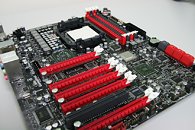Monday, May 10th 2010

ASUS ROG Crosshair IV Extreme Features Hydra
Following the apparently-successful launch of the ROG Crosshair IV Formula, ASUS is preparing the second, even-higher end offering under the Republic of Gamers (ROG) series for the socket AM3 platform, the Crosshair IV Extreme. First pictured and detailed in March, the Crosshair IV Extreme turned out to be a little more than just a beefier Crosshair IV Formula with a stronger VRM and more expansion slots; it has an important addition to its feature-set which was revealed after some websites pictured the board without its chipset heatsink. The Crosshair IV Extreme makes use of the Lucid Hydra engine, with a 32-lane Hydra bridge chip that supports 3~4 graphics cards. While the AMD 890FX isn't deficient of PCI-Express lanes, the addition of Hydra gives the motherboard the unique ability to mix and match graphics cards, with special modes for pairing ATI GPUs, NVIDIA GPUs, and ATI + NVIDIA GPUs. Another feature that got revealed with the heatsinks off is the CPU VRM, which makes use of no less than 11 independent phases, and a super ML capacitor that helps voltage tuning with high precision, and conditions CPU voltage better than conventional capacitors. ASUS may choose Computex as the ideal launch-vehicle for the Crosshair IV Extreme.
Source:
Slashgear


31 Comments on ASUS ROG Crosshair IV Extreme Features Hydra
Would NV ever do something like this? Not in the forseable future - they are way to arrogant.
AMD rocks.
First of all this is in no way an AMD product, it is entirely engineered by Asus.
Secondly the Hydra driver doesn't support physx yet. Remember you have to install the Hydra driver and then the ati and Nvidia ones as "sub-drivers". That means the Hydra driver runs as a sort of a hypervisor that virtualizes other drivers instead of running them natively and that means we won't see physx any time soon.
Edit: This says a sort of different tale, it's only ASUS implementing Hydra:
www.techpowerup.com/107704/NVIDIA_Shuns_Lucid_Hydra.html
" The Lucid Hydra engine by design is vendor-neutral. It provides a sort of abstraction-layer between the OS and the GPUs, and uses the available graphics processing resources to upscale resulting performance. This effectively kills NVIDIA’s cut, as motherboard vendors needn’t have the SLI license, and that users of Hydra won’t be using SLI or Crossfire anymore. Perhaps fearing a loss of revenue, NVIDIA is working on its drivers to ensure that its GeForce GPUs don’t work on platforms that use Hydra. Perhaps this also ensures "quality control, and compatibility", since if the customer isn't satisfied with the quality and performance of Hydra, NVIDIA for one, could end up in the bad books. This could then also kick up warranty issues, and product returns. "
thanks,
Aqua